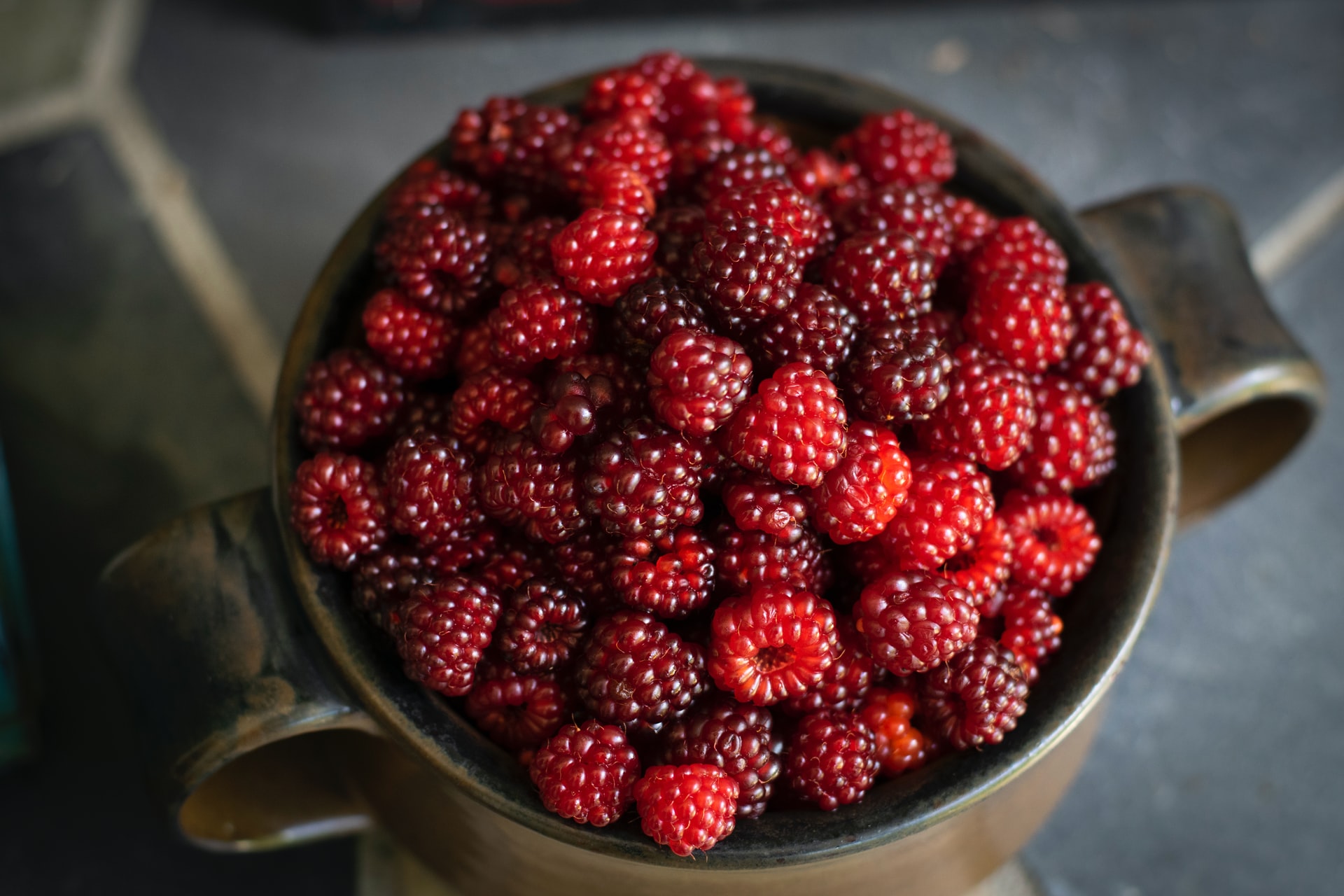Raspberries are easy to grow and are hardy across the country with the extreme north as the exception.
This article was first written for and first published on Earth, Food and Fire.
With many varieties to choose from, raspberries can be harvested from summer though to fall.

Raspberry Varieties
There are 2 main varieties of raspberries:
- summer fruiting (also known as June bearing) (floricanes)- berries that develop on last year’s growth
- everbearing (also known as Autumn bearing) (primocanes) – produce on new canes in the fall and can produce fruit the next summer. Production usually begins in mid to late August. Areas with long growing seasons are ideal for primocane raspberries.
The crowns and roots of raspberry plants are perennial, though the canes which grow are biennial, which means the individual canes live for 2 years. The new shoots, or suckers, are sent up every year. In the first year, suckers complete their physical growth and go dormant for the winter, in the following year, these canes bear fruit and die.
Growing an assortment of both varieties allows you to have a fresh harvest of berries the entire season.
Summer Bearing (floricane) Varieties
Boyne: Early to mid-season berries that are medium sized, medium to dark red fruit. Very hardy, productive, moderately vigorous, suckers freely. Berries freeze well. Canes are upright and very spiny with little branching.
Festival: Mid-season berries that are medium to light red fruit, with good productivity. Good flavor and great for freezing.Canes very short and hard.
Killarney: Mid-season berries on very productive plants. Berries are medium to light red and freeze well. Canes are strong, spiny and hardy.
Autumn Bearing (primocanes) Varieties
Red River: Medium sized berries, spines on canes are sparse, earliest producer.
Double Delight: Small to medium sized, firm berries, early producer.
Summit: Small to medium size berries. The canes have a few scattered spines.
Autumn Bliss: Large, oval shaped dark red berries, canes are quite spiny and erect.
Fall brook: Large, bright-red sweet berries on spiny canes.

Where Should I Plant my Raspberries?
Raspberries like full sun though they will tolerate some shade. They need well drained soil as the roots are susceptible to rot and are just beneath the surface of the soil. Do not plant where the is a chance of standing water.
If you garden in an area where there is a lot of clay in your soil raised beds are a great alternative.
How Do I Plant Raspberries?
Prepare the planting site by digging the spot well, loosening the soil and adding amendments like peat moss, well rotted manure and/or compost.
Raspberries do well if planted in well spaced out rows. Rows should be 2 meters apart and plants 18 inches apart within those rows. Plants can get quite heavy with berries so using a trellis system to hold the plants upright is a great option.
You can buy raspberry canes at your local greenhouse or garden center. Plant early in spring once the danger of frost has passed.
Dig a hole large enough for the roots or crown. Place plants at their original planting depth. Burying the crown too deep may result in rot. Be sure to pat down the soil around the roots and water plants immediately after planting. Using sharp hand pruners cut the canes back to 6 – 9 inches tall. This helps promote and encourage good root growth.
It is important to note that you must not allow the roots to dry out during the planting process as this will cause your canes to die. Keep the roots wrapped and wet up until ready to go into its planting location.
What Care Is Needed for Raspberries?
Because the root systems of raspberry plants are so shallow they require frequent watering. If they dry out you will see a reduced harvest, loss of vigor in your plants and greater chance for disease or complete loss. It is worth considering using a mulch on your raspberry plants to maintain moisture in the soil. Plants will benefit from a regular watering routine rather than random deep watering.
The plants will send out suckers which will quickly grow and take over your tidy raspberry patch. You can dig these up and replant them in another location to grow your patch size.
Pruning Raspberries
Pruning your raspberries is vital to maintain healthy plants. In the spring prune the raspberry patches removing old canes. It is easy to tell which years growth is older as it has a darker woody stem. The newer growth is green.
You can prune summer bearing canes as soon as you are done harvesting. The canes that did produce berries can be cut down to ground level, those will be the second year canes. Fall bearing canes can be cut down to ground level in March or April every year.

Picking and Storing Berries
You know your berries are ready to harvest when they are firm, full, bright red and come away from the plant easily. It is best to pick berries during the cooler times of the day. Use shallow bowls and trays so that you avoid crushing the berries. Raspberries have a fairly short shelf life and can be placed in the fridge for up to 5 days.
Do not wash before storing as this will cause them to go mushy as well as mold quickly. If you absolutely do need to wash your raspberries allow them to dry completely before storing in the fridge. Place in shallow or smaller containers to avoid crushing the berries.
Raspberries freeze well. Spread clean berries on parchment lined baking sheets to freeze. Once frozen bag and date them for long term storage.









